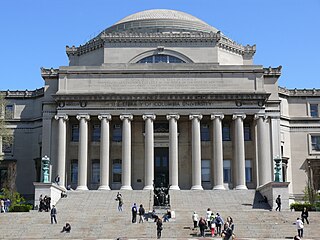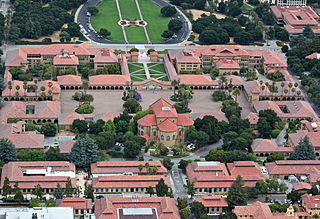
The Cecil H. Green Library is the main library on the Stanford University campus and is part of the SUL system. It is named for Cecil H. Green.

Sterling Memorial Library (SML) is the main library building of the Yale University Library system in New Haven, Connecticut, United States. Opened in 1931, the library was designed by James Gamble Rogers as the centerpiece of Yale's Gothic Revival campus. The library's tower has sixteen levels of bookstacks containing over 4 million volumes. Several special collections—including the university's Manuscripts & Archives—are also housed in the building. It connects via tunnel to the underground Bass Library, which holds an additional 150,000 volumes.


The Morgan Library & Museum, formerly the Pierpont Morgan Library, is a museum and research library in the Murray Hill neighborhood of Manhattan in New York City. It is situated at 225 Madison Avenue, between 36th Street to the south and 37th Street to the north. The Morgan Library & Museum is composed of several structures. The main building was designed by Charles McKim of the firm of McKim, Mead and White, with an annex designed by Benjamin Wistar Morris. A 19th-century Italianate brownstone house at 231 Madison Avenue, built by Isaac Newton Phelps, is also part of the grounds. The museum and library also contains a glass entrance building designed by Renzo Piano and Beyer Blinder Belle. The main building and its interior is a New York City designated landmark and a National Historic Landmark, while the house at 231 Madison Avenue is a New York City landmark.

Grace Cathedral is an American cathedral of the Episcopal Church in San Francisco, California. On top of Nob Hill, Grace is the cathedral church of the Episcopal Diocese of California, led by Bishop Marc Andrus since 2006, while the cathedral's local parish has been led by Dean Malcolm Clemens Young since 2015.
Thomas Barbour Lathrop was an American philanthropist and world traveler.

The Leland Stanford Mansion, often known simply as the Stanford Mansion, is a historic mansion and California State Park in Sacramento, California, which serves as the official reception center for the Californian government and as one of the official workplaces of the Governor of California.

Hoover Tower is a 285 feet (87 m) structure on the campus of Stanford University in Stanford, California, United States. The tower houses the Hoover Institution Library and Archives, an archive collection founded by Herbert Hoover before he became president of the United States. Hoover had amassed a large collection of materials related to early 20th century history; he donated them to Stanford, his alma mater, to found a "library of war, revolution and peace". Hoover Tower also houses the Hoover Institution research center and think tank.

The Low Memorial Library is a building at the center of Columbia University's Morningside Heights campus in Upper Manhattan, New York City, New York, United States. The building, located near 116th Street between Broadway and Amsterdam Avenue, was designed by Charles Follen McKim of the firm McKim, Mead & White. The building was constructed between 1895 and 1897 as the university's central library, although it has contained the university's central administrative offices since 1934. Columbia University president Seth Low funded the building with $1 million and named the edifice in memory of his father, Abiel Abbot Low. Low's facade and interior are New York City designated landmarks, and the building is also designated as a National Historic Landmark.

The Mark O. Hatfield Library is the main library at Willamette University in Salem, Oregon, United States. Opened in 1986, it is a member of the Orbis Cascade Alliance along with several library lending networks, and is a designated Federal depository library. Willamette's original library was established in 1844, two years after the school was founded. The library was housed in Waller Hall before moving to its own building in 1938.

The Gould Memorial Library is a building on the campus of the Bronx Community College (BCC), an institution of the City University of New York (CUNY), in University Heights, Bronx, New York City, United States. The building was designed by Stanford White of the firm McKim, Mead & White. Constructed between 1895 and 1900 as the central library of New York University (NYU)'s Bronx campus, it was part of the New York University Libraries system. The library is named after railroad magnate Jay Gould, whose daughter Helen Miller Shepard funded the project in his memory. Gould is no longer used as a library, instead serving primarily as an event space. Gould's facade and interior are New York City designated landmarks, and it is also listed on the National Register of Historic Places.

The Stanford University Libraries (SUL), formerly known as "Stanford University Libraries and Academic Information Resources" ("SULAIR"), is the library system of Stanford University in California. It encompasses more than 24 libraries in all. Several academic departments and some residences also have their own libraries.

Lane Medical Library is the library of the Stanford University School of Medicine at Stanford University, near Palo Alto, California. Its mission is to "accelerate scientific discovery, clinical care, medical education and humanities through teaching, collaboration, and delivery of biomedical and historical resources". It is located on campus adjacent to Stanford Hospital and Clinics. In addition to books, journals and documents for medical research and the teaching and practice of medicine, Lane Library houses a significant collection of material relating to the history of medicine. The library also provides specialized search capabilities, classes and tutorials, writing and grant support, and group and individual study spaces.

The Sophia Astley Kirkpatrick Memorial Chapel, known as Kirkpatrick Chapel, is the chapel to Rutgers, The State University of New Jersey and located on the university's main campus in New Brunswick, New Jersey in the United States. Kirkpatrick Chapel is among the university's oldest extant buildings, and one of six buildings located on a historic section of the university's College Avenue Campus in New Brunswick known as the Queens Campus. Built in 1872 when Rutgers was a small, private liberal arts college, the chapel was designed by architect Henry Janeway Hardenbergh at the beginning of his career. Hardenbergh, a native of New Brunswick, was the great-great-grandson of Rutgers' first president, the Rev. Jacob Rutsen Hardenbergh. It was the third of three projects that Hardenbergh designed for the college.


The Main Library is a historic library on the campus of the University of Illinois Urbana-Champaign in Urbana, Illinois. Built in 1924, the library was the third built for the school; it replaced Altgeld Hall, which had become too small for the university's collections. Architect Charles A. Platt designed the Georgian Revival building, one of several on the campus which he designed in the style. The building houses several area libraries, as well as the University Archives and the Rare Book & Manuscript Library. The Main Library is the symbolic face of the University Library, which has the second largest university library collection in the United States.

The Lathrop Library is one of several libraries at Stanford University in California. It is the current undergraduate library and houses the East Asia Library. Part of the Stanford University Libraries system, it opened on September 15, 2014 and houses collections and services formerly located in J. Henry Meyer Memorial Library, which was demolished in 2015. The library is located in a renovated building formerly occupied by the Stanford Graduate School of Business.

The Harrison Memorial Library is a historic building designed by architect Bernard Maybeck and built by Michael J. Murphy in 1928. It houses a public library for the city of Carmel-by-the-Sea, California. The library provides books, materials and programs that support the pursuit of education, information, recreation, and culture. It includes documents about the history and development of Carmel and the Monterey Peninsula. The Harrison Memorial Library was named after California Supreme Court Justice Ralph C. Harrison. It was designated as an important commercial building in the city's Downtown Historic District Property Survey, and was recorded with the Department of Parks and Recreation on November 18, 2002.



















